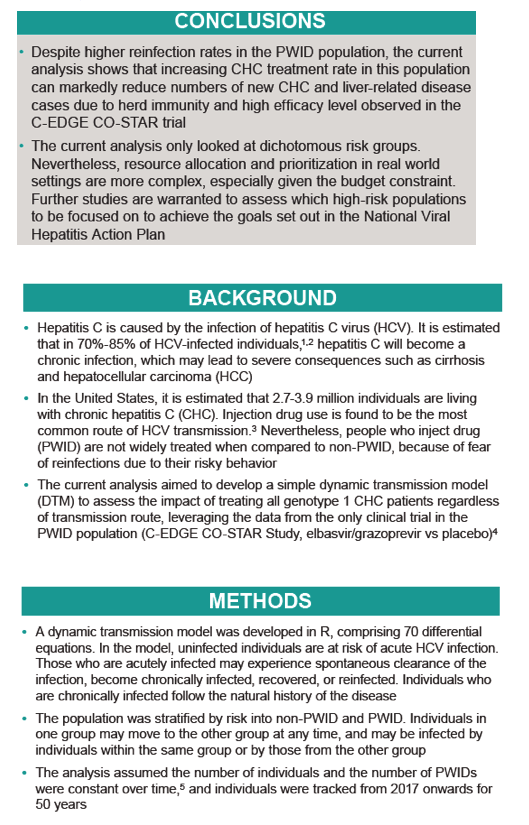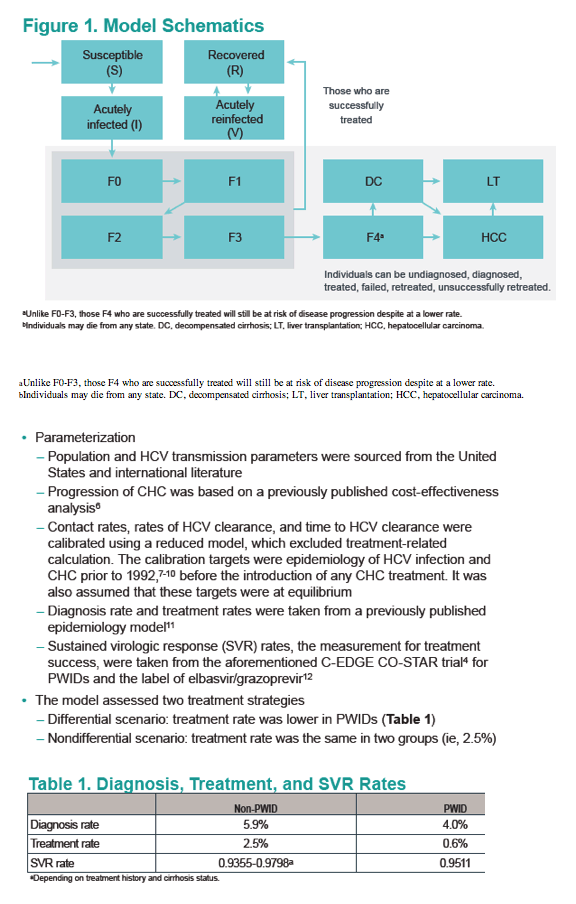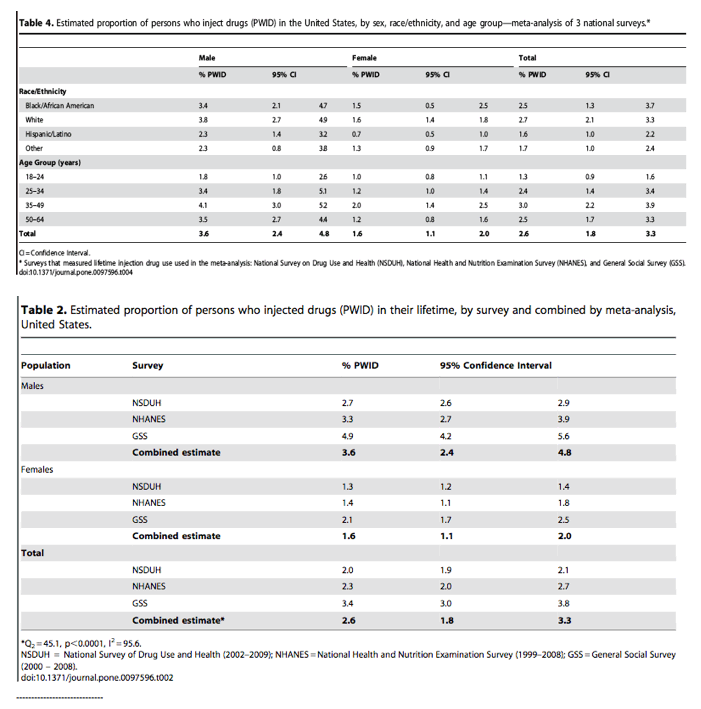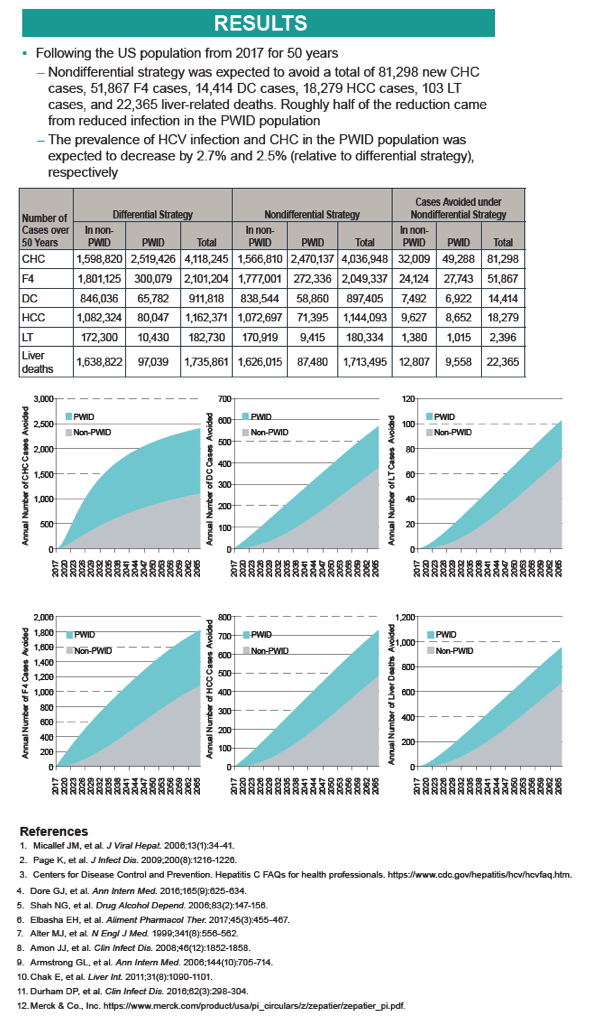 |
 |
 |
| |
Epidemiologic Impact of Expanding Chronic Hepatitis C (CHC) Treatment in People Who Inject Drug in the United States: A Mathematical Model Using Data From the C-EDGE CO-STAR Study
|
| |
| |
Reported by Jules Levin
AASLD Annual Meeting 2017, Washington, DC, USA, October 20-24
Yiling Jiang1; Chizoba Nwankwo2
1Merck Sharp & Dohme Ltd., Hoddesdon, Hertfordshire, UK;
2Merck & Co., Inc., Kenilworth, NJ, USA
from Jules: there is little funding and overall resolve to implement a national program or by any state, at this time, to Eliminate HCV which would require a comprehensive dedicated screening, linkage, and treatment program; such a program necessitates special support services for the drug using community (IDUs, etc), and requires resources, adequate funding and services. But at this time there is no indication that any state or the federal government is considering this. In NYS where routine HCV screening was mandated about 4-5 years, it is NOT been very useful, there is no enforcement or real requirement ant many if not most ignore this regulation. Although several states have apparently recently eliminated disease stage restriction and this is good this is in the overall picture not a great deal of movement & accomplishment considering its been 4-5 years since the new DAAs have been FDA approved. Clearly no state or the federal government wants to commit the resources or funding required, despite that DAA pricing has been reduced by 50-70% which raises a good question - will any price convince state and federal authorities to implement a national HCV Elimination program, at this point in time there is NO indication any price will be low enough to convince state & federal authorities to spend the money needed for a comprehensive fully inclusive Elimination Program which would require IDUs and all others be included; including IDUs requites extra resources & funding for services, this does not appear on the horizon at this time. Instead slow & steady changes are occurring at a snail's pace so it could take another 10-15 years or 20 years or never to get close to our goal of HCV elimination. Even with ex government funding a state would have to commit to large scale project, which still entails commitment & resource allocation for years.


aDepending on treatment history and cirrhosis status.
IDUs 2.6% of US Population, MSM 3.9%/6.9% Ever Engaged -
CDC....http://www.natap.org/2012/HIV/121912_04.htm
PWIDs in the USA (6.6 million ever - 770,00 in last year injected drugs).....http://www.natap.org/2014/HCV/071614_04.htm
Estimating the Number of Persons Who Inject Drugs in the United States by Meta-Analysis to Calculate National Rates of HIV and Hepatitis C Virus Infections ......http://www.natap.org/2014/HCV/053014_01.htm"The prevalence estimate points to the importance of national efforts to raise awareness of HCV testing among persons who have injected drugs......the prevalence data may be an under-estimate of the population proportion of PWID.....In an era of improved treatment, it is also important that those who are infected are linked to appropriate care [11]. CDC recommends integrated prevention services for PWID, which address risk for HIV and HCV infections and are expected to result in increased access to services, improved timeliness of service delivery, and increased effectiveness of prevention efforts [26]."
"Using data from national population-based U.S. surveys, we estimated that persons who ever injected drugs comprised 2.6% (CI: 1.8%-3.3%) of the U.S. population....in 2011......we estimate that approximately 6,612,488 adults and adolescents ever injected drugs, with a range from 4,583,188 to 8,641,788 persons.....The combined estimate for males was 3.6% (CI: 2.4%-4.8%) and for females was 1.6% (95% CI: 1.1%-2.0%).......for 2011, we estimate that approximately 774,434 adults and adolescents (range: 494,605-1,054,263) injected drugs in the past year in the United States."
Our HCV infection prevalence rate among PWID aged 40-65 years was 43,126 per 100,000 population, reflecting the substantial impact of injection drug use on acquiring HCV infection. The HCV infection prevalence we found (43.1%) was similar to a previous NHANES estimate of 48%...


|
| |
|
 |
 |
|
|